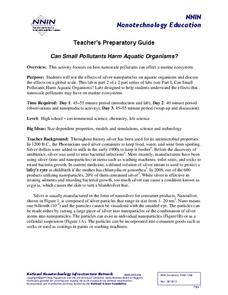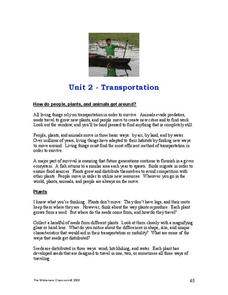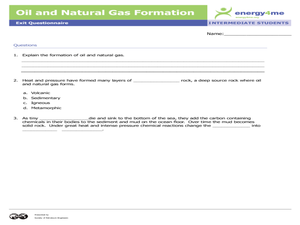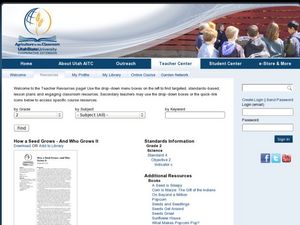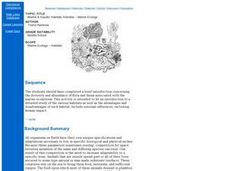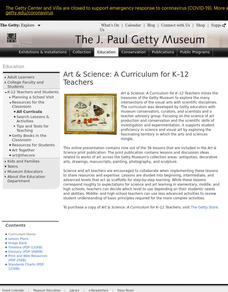Science Matters
Celery Lab
See firsthand the work plants do to move nutrients through their systems with a lesson that demonstrates the role of the xylem and phloem in plants. Young scientists observe celery move colored water through its stem to the leaves and...
National Nanotechnology Infrastructure Network
Can Small Pollutants Harm Aquatic Organisms?
Nanoparticles have toxic effects on plant and animal life—even though you can't see them. The second lesson of a two-part series has young scientists conduct an experiment that exposes plant and animals to nanoparticle pollutants. They...
Curated OER
Carnivorous Plants: A Bugs Nightmare!
Students research carnivorous plants and how they trap insects. They role play as botanists to write a research field guide about a newly discovered imaginary carnivorous plant.
Curated OER
Transportation
Students read about various modes of transportation for people, plants, and animals. In this transportation lesson, students read information about the transportation modes for people plants, and animals using water and land. Students...
Curated OER
Animals
First graders study the basic needs of animals and compare them to human needs. They make bird feeders using milk carton and pine cones. They review the basic needs of food, water, air, and shelter and discuss what happens when animals...
Curated OER
Sunken Millions
This PowerPoint features a game based on the animal life. The interactive slides include 20 questions about animal needs, animal groups, and animal traits. The questions include multiple choice answers and 4 different levels of...
Curated OER
Oil and Natural Gas Formation
Students complete a narrative paper and a drawing depicting how the formation of oil and natural gas taken from the Earth's crust were once plants and animals millions of years ago. In this oil and natural gas lesson plan, students read,...
Curated OER
Critters in Your Own Backyard
Pupils identify various animals and their habitats, as well as their specific traits In this animal habitat lesson, students list animals they've seen in their backyard. Pupils select one animal and do research. Students then answer 9...
Curated OER
Go Fish!
Students are introduced to the culture of the Kumeyaay. Using their text, they discover how they used their native flora and fauna in San Diego. They participate in a matching game and examine the types of organisms who make their home...
Curated OER
COMPARE SOILS BY GROWING PLANTS
The student will identify the difference in the rate of plant growth in three soils that vary in organic matter.1. Obtain three to four flowerpots, different types of soil, a record chart, three to five beans for each pot, and water....
Curated OER
How a Seed Grows and Who Grows It
First graders explore biology by viewing PowerPoint presentations in class. In this plant life lesson, 1st graders identify the life cycle of a plant and how to properly plant a seed outside. Students view a movie about plant life and...
Curated OER
Little Red Hen
First graders explore biology by identifying plant anatomy in class. In this botany lesson, 1st graders read the book The Little Red Hen and identify the methods used in order to grow successful plants. Students discuss other ways people...
Curated OER
Marine & Aquatic Habitats Activities - Marine Ecology
Students enact the life cycle of a sessile animal and quantify the possibility of survival under the conditions given. They then present to the class a new adaptation which will increase the animals chance of survival.
Curated OER
Prehistory Prowl
In this North Dakota prehistory activity worksheet, students study the mastodon, bison, native plants, and native people of North Dakota as they respond to 21 drawing, graphic organizer and matching questions.
Curated OER
The Way a Tree Works
Students explore nature by conducting botany experiments. For this plant life lesson, students define the necessary resources for a plant to thrive on our planet while defining scientific vocabulary terms. Students utilize different...
Curated OER
Africa: Animals of the African Savannahs
Students explore animals of the savannah. For this science lesson, students discuss the characteristics of animals that live on the savannah. Students create an animal that would be able to live on the savannah.
Curated OER
Key Figures of the 1899 Harriman Alaska Expedition
Pupils gain general knowledge of the goals, route, participants, and significance of the 1899 Harriman Expedition. They link names of glaciers, fiords, mountains, flora and fauna with names of the 1899 Harriman Expedition participants. ...
Curated OER
The Busy Pond
In this pond ecosystem mini book worksheets, students cut out, color, and study the pond plants, animals, and ecosystem by creating a mini book.
Curated OER
Who Eats Who?
Students recognize that some animals eat plants, some eat meat and some both. For this who eats who lesson, students chart animals in a food chain. Students research information from reading articles. Students chart what animals eat...
Curated OER
Clearly Classified
Young scholars review the classification system for living organisms and apply it the classification of insects and flowers in the still life by Ambrosius Bosschaert. They create a chart classifying the animals and plants in the painting...
Curated OER
Habitats of the World
Students discover that the Earth supports many different animal habitats. For this habitat lesson students research different habitats of the world. Students show how the animals in their habitat are adapted.
Curated OER
Geologic Time Scale II
Students research the geologic time scales and the appearance of animals and plants during these eras. They complete a chart indicating the era, period and major events.
Curated OER
Creating New Forms of Life
High schoolers are asked to use their imaginations to take the idea of biotechnology one step further. Before beginning this activity students read and complete a report on the book "Jurassic Park," which deals with the use of...
Curated OER
Interdependence and Adaptation
Fifth graders construct a food web to illustrate how animals and plants are interdependent. In this interdependence lesson, 5th graders identify how consumers, producers, herbivores, carnivores and predators are related in a habitat....
Other popular searches
- Plants and Animals
- Arctic Plants and Animals
- Aquatic Plants and Animals
- Coastal Plants and Animals
- Artic Plants and Animals
- Plants and Animals Needs
- Plants and Animals Interact
- Desert Plants and Animals
- Plants and Animals Die
- Attic Plants and Animals
- Comparing Plants and Animals
- Animals Plants and Water



